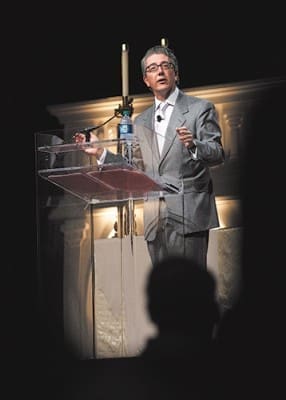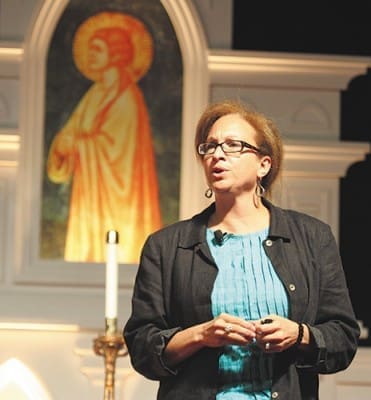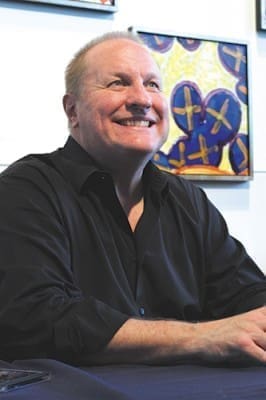 Photo by Michael Alexander
Photo by Michael AlexanderCollege Park
English Track Speakers Extol Blessed Mother, Eucharist
By MARY ANNE CASTRANIO, Staff Writer | Published June 6, 2013
COLLEGE PARK—With word, song, action and art, the speakers in the English track of the 2013 Eucharistic Congress inspired and informed the thousands gathered to listen and learn. The six presenters touched on the themes of the Real Presence of Christ in the Eucharist, the importance of Scripture, the call to holiness and the role of Mary.
Those attending included longtime participants as well as first-time attendees. The congress is an event Mark and Jen Faas look forward to every year.
“I see friends and hear some of the speakers,” Mark Faas said. “I’m surrounded by like-minded people; it just feels good to be here.”

Frank J. Hanna III, CEO of Hanna Capital, Atlanta, leads off the day of talks in the English track. Photo By Thomas Spink/Archdiocese of Atlanta
Coming to the congress for the first time this year, Joan Oscar, of St. Pius X Church in Conyers, called the event “absolutely wonderful.” Having moved to the Atlanta area four years ago from the Northeast, Oscar said she had been to other Catholic events and conferences, but this was special.
“It’s a reawakening,” said the choir cantor. “It’s another step.”
Mary’s Word ‘Can Change Your Life’
The first speaker was Atlanta investment banker and philanthropist Frank Hanna III. In the context of the theme of the congress, “Do whatever he tells you,” Hanna shared the story of how he was able to acquire for the church the famous Bodmer Papyrus XIV-XV, which contains the oldest existing copy of the Gospel of St. Luke and one of the oldest copies of the Gospel of St. John. Hanna purchased and donated the papyrus to the Vatican Library in 2007. (The Bodmer Papyrus was discovered in Egypt in 1952 and held by a foundation, which offered these two sections for sale.) The manuscript also contains the oldest existing copy of the Lord’s Prayer, in Luke 11:1-4.
Hanna said that the word “whatever” in Mary’s instruction to the servers at the wedding of Cana, and to all Christians, is a powerful word—one that is “dangerous.”
“Following the rule of ‘whatever’ can change your life,” he said.
First contacted about purchasing this portion of the Bodmer Papyrus in 2006, he initially resisted: “What in the world does it have to do with me?” He later came to see that the papyrus would be a “gift of inestimable worth” to the church.
Hanna focused on the significance of the papyrus. He said that there is one God, who came to earth one time. God gave us one prayer—and these pages contain the earliest copy of that prayer.
Hanna said, “I wouldn’t have had light and joy and peace in my heart if I didn’t try” to get this manuscript for “our church.” Six months of negotiations later, he was able to obtain the papyrus, and in January 2007 he and his family presented it to Pope Benedict XVI at the Vatican.
He described that moment, as the pope read from the pages. “We stood side-by-side, hearing the Vicar of Christ read in Greek the beginning of the Gospel of John in the oldest edition known.” Hanna said that the beginning of that Gospel sums up our faith, “In the beginning was the Word, and the Word was with God, and the Word was God.”
“We have a treasure beyond all others,” he said. “We have our faith.”
Hanna ended his talk with a discussion of wealth and Western culture. It’s not material goods, he said.
“All the best things in my life are gifts: my parents, wife, daughter,” and faith and hope above all, he said.
Empty ‘Mental Junk Food’
EWTN speaker and author Marcellino D’Ambrosio, Ph.D., focused on the gift of the Eucharist. He said, “The Eucharist is given to us so we can bear fruit for the Lord.”
D’Ambrosio emphasized the Real Presence of Christ in the Eucharist. He talked about the mystical body of the Church and how the heavenly Church with the saints and the deceased are unified with the faithful on earth, “gathered together” in the Mass.
In the Eucharist, D’Ambrosio said, “We can see, touch and receive it. We consume it. The Lord Jesus gives himself in the form of food.”
He also talked about faith as a “gift that needs to be developed.” Trials and prayers are means of exercising one’s faith, he said.
D’Ambrosio suggested that “we should empty ourselves of the mental junk food that fills our minds … turn everything off—empty yourselves.”
He ended his talk with a call to pray for others, forgive, and “bring more mercy to Mass.”
“Make it a pledge not to come unprepared for Mass.”
The Woman Most Represented In Art
As she did for her talk the previous evening at the Revive track, art historian and professor Dr. Elizabeth Lev brought a slideshow of images of art masterpieces to illuminate the points she made about Mary and Jesus.
Initially drawn to art history because of the pagan images of mythology, Lev said that she did not truly understand art until she moved to Italy, where she saw “art in its natural habitat—in the church.”

Art historian Dr. Elizabeth Lev addresses the audience in the English track. Photo By Michael Alexander
Drawing too on the congress theme, she pointed out that Mary is “the most represented woman in history” in art, humorously observing that well-known women such as Princess Diana and Angelina Jolie have nothing to compare with the Blessed Mother in terms of the number of images around the world.
Lev also said that the goddesses that she once was so drawn to “were not so great.” Showing glorious images of masterworks by artists such as Caravaggio, Donatello, Gentileschi, Michelangelo, and da Vinci, over and over she demonstrated her point that Mary and biblical women who prefigured her (Eve, Esther, Judith) illustrated the strength of faithful women of God.
Lev said that the earliest Christian devotion is to Mary—the “first image in Christian art is Mary.”
“It’s so important to them that it raised the status of women in the ancient world,” she said. For every male martyr, she said, there is a female martyr.
Praying And Christ’s Passion
Doug Barry, along with musician Eric Genius, brought something new to the English track: a one-man dramatization of the Passion, with Barry playing various roles.
Barry spoke prior to the presentation, telling the crowd, “We can always turn to God for consolation and healing. He’ll never turn his back. Don’t ever stop praying.”
As he acted out the Passion of Jesus with words and music, Barry interjected the problems of the modern world, using Gethsemane as a springboard to pray for “children, everything to come, religious liberty, sexual sins, neglect.”
“Who here is not sick with sin … greed, lust, gossip, discouragement, confusion,” he cried out.
During the crucifixion scene, Barry said, “When truth comes before us, how do we respond? Do we beat it down or do we proclaim that truth?”
“The eyes of Jesus met the eyes of his mother,” said Barry. “Thank you for your love for me. Thank you for saying yes.”
At the conclusion of the drama, Barry told the crowd not to lose hope or courage. “He is a faithful God.”
Becoming Catholic ‘Best Decision I Ever Made’
Country music singer and recording artist Collin Raye graced the English track with several songs related to his talk. He began by singing his familiar hit, “Love, Me” and went on to share his conversion story. Raised a Baptist in Texas, he told about his upbringing and foundation in faith taught by his mother. He said, however, he was always attracted to the Catholic Church.
While working in Portland, he attended Mass for the first time with friends who later became his sponsors. Raye said that he had not grown up aware of the Real Presence of Christ in the Eucharist, but when he first walked into Our Lady of Sorrows Church in Portland, Ore., “I had a massive feeling that something really important is here.”

Collin Raye, a country music singer and convert to Catholicism, greets and signs his CDs for patrons. Photo By Michael Alexander
He said, “That feeling has never left me.” His decision to become Catholic was the “best decision I ever made.”
Raye talked about the events and parts of his life that have been faith testers—especially tragedy within his family.
He said, “Tragedy will bring you to your knees.”
His young granddaughter, Haley, “born perfect,” he said, became ill at age 3 with an undiagnosed neurological disorder. She continued to decline and died at 9.
Raye said that as the patriarch of the family, he thought he could fix anything and assumed “that God will do it (heal Haley) because we asked.” Their prayers for her recovery were denied at every turn, he said.
In spite of his family’s loss, Raye said their faith got stronger. “She blessed us for those nine and a half years and then she moved on.”
“It taught me that she belonged to God.”
Raye said, “We’re all going to have our tragedies and our losses, but it’s all part of the journey. Praise him anyway.”
He ended with a poignant song written for Haley, “She’s With Me” and then led attendees in singing the familiar Eucharistic hymn, “I Am the Bread of Life.”
Share Catholic Faith In Friendships
Scott Hahn, Ph.D., closed out the English track with a fervent, meticulously researched call for the new evangelism, giving it an historical context. The new evangelization is the mission of all Catholics, he said, adding that it is a mission to re-evangelize the de-Christianized, as well as to evangelize those who don’t know Christ.
Blessed John Paul II, Pope Emeritus Benedict XVI and Pope Francis have challenged the laity to “get involved … and share the faith with … family and friends.”

Scott Hahn, Ph.D., is the sixth and final presenter in the English track. Photo By Thomas Spink/Archdiocese of Atlanta
Hahn talked about his past as an evangelical Protestant, when to be saved all one had to do was believe that “God loves you, you’re a sinner, Christ died for our sins, and what are you going to do about it.” He said this is a good basis, but it’s not Eucharistic—it’s just the beginning.
“We are called to learn to share our faith as Catholics,” he said, adding, “Evangelical Catholic is not an oxymoron.” Evangelization is “done in the course of friendships and relationships.”
As an example Hahn recounted a dialogue he had had with a high school friend who had once been Catholic and was now Protestant. The two talked over some months about their beliefs, the scriptural basis for the Eucharist, and the covenant between Jesus and those who believe. At the end of their discussions, his friend returned to the Catholic Church, convinced.
Hahn, who has recently published a book on the new evangelization, said that Catholics are called to share their beliefs, their faith and their love for God with those they love—“share what we enjoy in life in the context of friendship because that’s what friends do.”